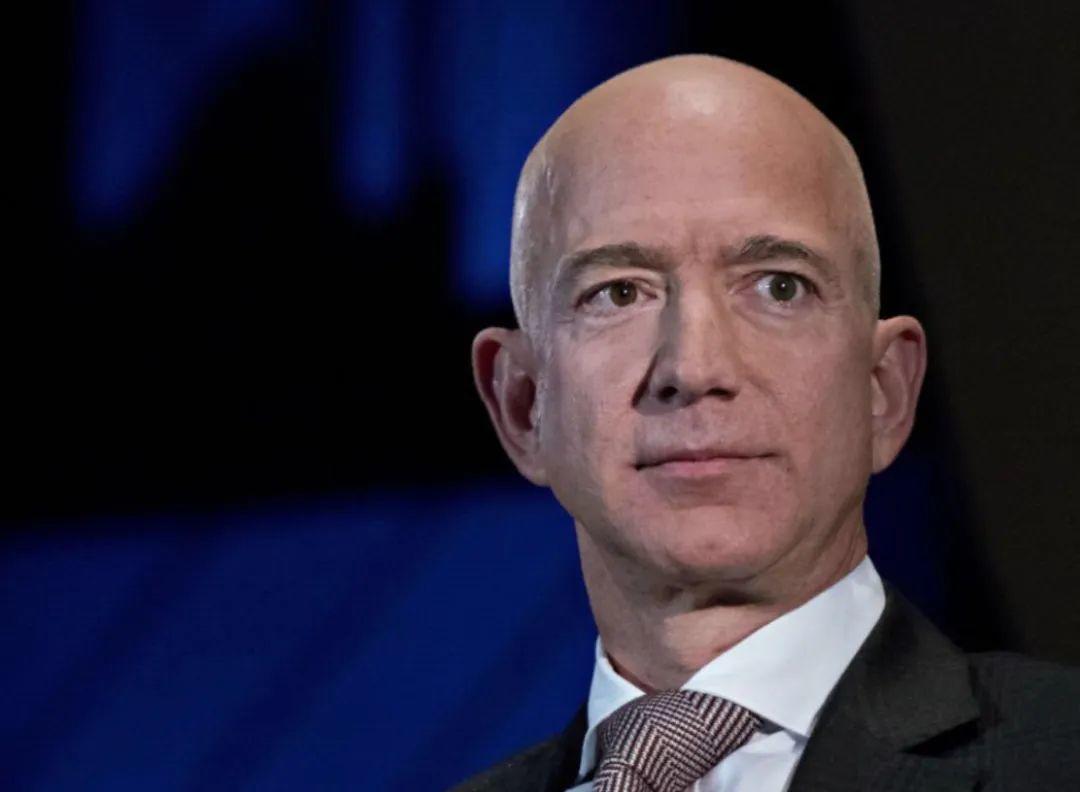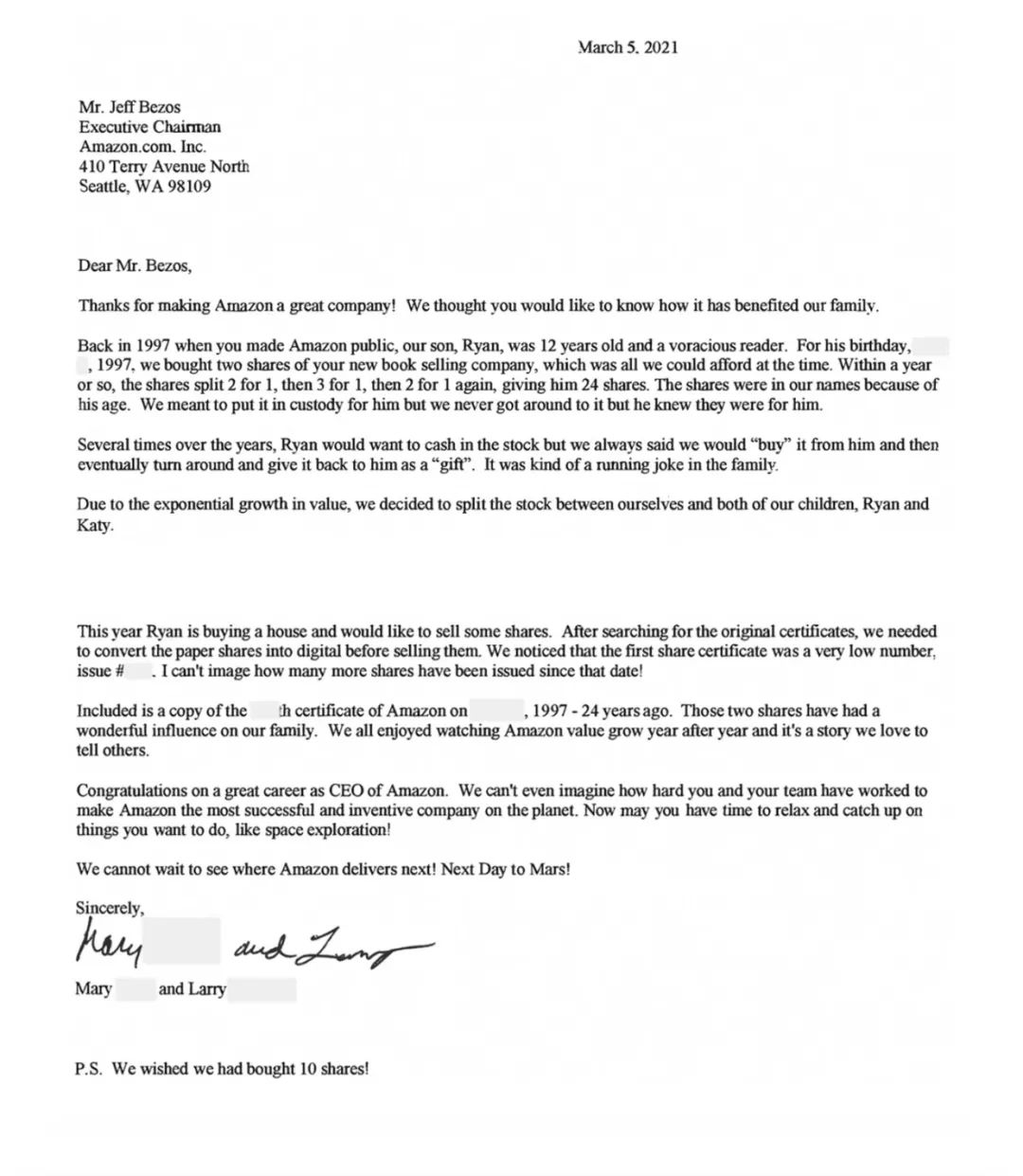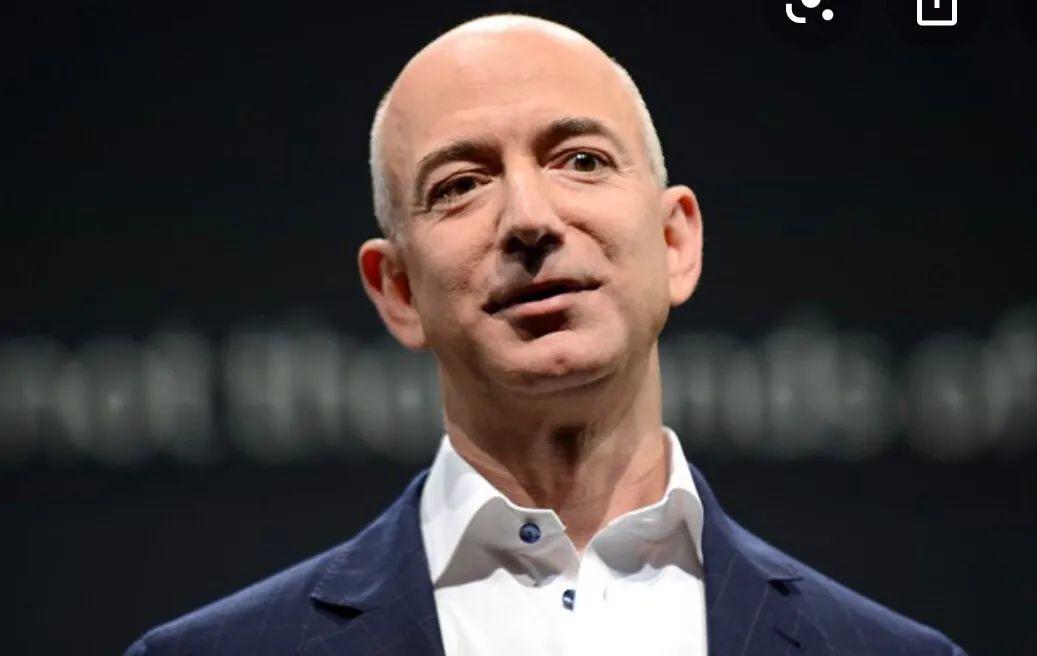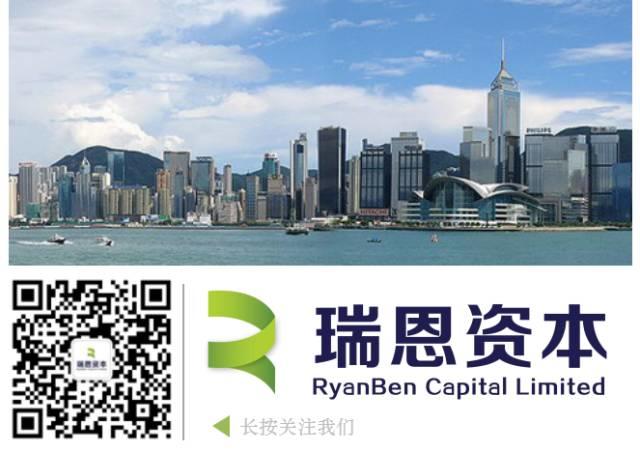來源 | 繼民財經匯

亞馬遜 CEO致股東信 2021(全文)
(中文翻譯僅供參考,英文原文為準)
只有差異化才能生存,宇宙需要你與眾不同
致我們的股東:
在亞馬遜於1997年致股東的一封信中,我的第一封信中談到了我們希望建立一個「經久不衰的特許經營權」的希望,這種特許經營將通過釋放互聯網的力量來重塑為客戶服務的意義。我注意到亞馬遜已經從擁有158名員工增長到614名,並且我們已經擁有超過150萬個客戶帳戶。我們剛剛以拆分後的每股1.50美元的股價公開發行。我寫道那是第一天。
自那時以來,我們已經走了很長一段路,並且我們比以往任何時候都更加努力地為客戶服務並取悅他們。去年,我們僱用了500,000名員工,現在在全球範圍內直接僱用130萬人。我們在全球擁有超過2億的Prime會員。我們的商店銷售着超過190萬家中小型企業,它們約佔我們零售總額的60%。客戶已將超過1億個智能家居設備連接到Alexa。亞馬遜網絡服務為數百萬客戶提供服務,到2020年年底,年化運行率將達到500億美元。在1997年,我們還沒有發明Prime,Marketplace,Alexa或AWS。那時他們甚至都不是主意,也沒有人命中注定。我們對每個人都冒着很大的風險,並為每個人付出了汗水和創造力。
在此過程中,我們為股東創造了1.6萬億美元的財富。他們是誰?您的主席是一位,而我在亞馬遜的股份使我變得富有。但是其他人擁有超過七分之八的股份,代表1.4萬億美元的財富創造。他們是誰?他們是養老基金,大學和401(k)賬戶,是瑪麗和拉里(Mary and Larry),他們像我坐下來寫這封股東信時一樣,突然發給我這張紙條:

一直有類似的故事與我接觸。我知道有人用亞馬遜的錢來上大學,緊急事件,房屋,度假,開辦自己的生意,慈善事業–清單還在繼續。我為我們為股東創造的財富感到自豪。這很重要,可以改善他們的生活。但是我還知道其他一些東西:這不是我們創造的價值的最大部分。
創造比您更多的消費
如果您想在業務上(實際上是在生活中)成功,那麼您必須創造出更多的消費能力。您的目標應該是為與您互動的每個人創造價值。即使表面上看起來很成功,也沒有為其所創造的價值創造價值的任何企業對於這個世界來說都不是長久的。它正在出路。
請記住,股價與過去無關。他們是對未來現金流量折現到現在的預測。股市預期。我將轉瞬即逝,談論過去。我們在2020年為股東創造了多少價值?這是一個相對容易回答的問題,因為已建立了會計系統來回答該問題。2020年,我們的凈收入為213億美元。如果亞馬遜不是擁有數千名所有者的上市公司,而是擁有一個所有者的獨資企業,那麼這就是所有者在2020年的收入。
員工呢?這也是一個很容易回答的價值創造問題,因為我們可以看看補償費用。公司的支出是僱員的收入。2020年,員工收入為800億美元,另外還有110億美元(包括福利和各種工資稅),總計910億美元。
第三方賣家呢?我們有一個內部團隊(銷售合作夥伴服務團隊)來回答這個問題。他們估計,到2020年,第三方賣家在亞馬遜上出售的利潤在250億美元至390億美元之間,保守起見,我將拿250億美元。
對於客戶,我們必須將其細分為消費者客戶和AWS客戶。
我們先做消費者。我們提供低廉的價格,豐富的選擇和快速的交貨,但是想像一下,出於這一估計的目的,我們忽略了所有這些,僅重視一件事:我們節省了客戶的時間。
客戶在三分鐘或更短的時間內完成了28%的購買,而所有購買的一半都在不到15分鐘的時間內完成。將其與實體商店的典型購物之旅進行比較-開車,停車,搜索商店過道,在結帳線等候,找到您的汽車以及開車回家。研究表明,一般的實體店旅行大約需要一個小時。如果您假設一次典型的亞馬遜購買需要15分鐘,並且為您節省一周去實體店的幾次旅行,那麼每年可以節省75個小時以上。那很重要 我們都忙着在早期21日世紀。
為了獲得一個美元的數字,我們將節省的時間定為每小時10美元,這很保守。75小時乘以每小時10美元,再減去Prime的成本,您為每個Prime會員創造的價值約為630美元。我們擁有2億個Prime會員,到2020年創造的價值總額將達到1260億美元。
AWS很難估算,因為每個客戶的工作量是如此不同,但是無論如何我們還是會做到這一點,並且要先確認錯誤率很高。在雲中運行與在本地運行相比,直接成本改善有所不同,但合理的估計是30%。到2020年AWS整個450億美元的收入中,這30%意味着客戶價值創造190億美元(這將使他們花費640億美元,而他們自己從AWS花費450億美元)。此估算工作的難點在於,直接降低成本是遷移到雲的客戶利益的最小部分。更大的好處是軟件開發速度的提高-可以顯着提高客戶的競爭力和收入。我們沒有合理的方法來估算那部分客戶價值,只能說它肯定比直接節省的成本要大。在這裡保守一點(記住我們實際上只是在嘗試獲得估算值),我會說相同,並稱2020年AWS客戶價值創造380億美元。
結合AWS和消費者,我們在2020年創造的客戶總價值將達到1640億美元。
總結:
股東 $ 21B
僱員 $ 91B
3P賣方 $ 25B
客戶 $ 164B
總計 $ 301B
如果每個小組都有代表他們與亞馬遜互動的損益表,那麼上面的數字將是這些損益表中的「底線」。這些數字是人們為我們工作,賣家通過我們出售商品以及客戶向我們購買商品的原因之一。我們為他們創造價值。這個價值創造不是零和遊戲。這不僅僅是將錢從一個口袋轉移到另一個口袋。在整個社會大放異彩,您會發現發明是所有真正價值創造的根源。最好將創造的價值視為創新的指標。
當然,我們與這些選區的關係以及我們創造的價值並不僅限於美元和美分。金錢並不能說明一切。例如,我們與股東的關係相對簡單。他們在選擇的期間內投資並持有股票。我們很少為股東提供指導,例如年度會議和投票表決股份的正確程序。即使這樣,他們也可以忽略這些指示,而只跳過投票。
我們與員工的關係是一個非常不同的例子。我們有他們遵循的流程和達到的標準。我們需要培訓和各種認證。員工必須在指定的時間出現。我們與員工的互動很多,而且它們的粒度很細。這不僅僅是工資和福利。關係的所有其他詳細方面也是如此。
您的主席對貝塞默爾最近的工會投票結果感到安心嗎?不,他沒有。我認為我們需要為員工做得更好。儘管投票結果不平衡,而且我們與員工的直接關係牢固,但對我而言,很明顯,我們需要對如何為員工創造價值擁有更好的願景,即為員工取得成功的願景。
如果您閱讀了一些新聞報道,您可能會認為我們不在乎員工。在這些報告中,我們的員工有時被指責為絕望的靈魂,被視為機械人。那是不正確的。他們是精明周到的人,可以選擇在哪裡工作。當我們對履行中心員工進行調查時,有94%的人說他們會推薦亞馬遜給朋友作為工作場所。
員工可以在輪班期間進行非正式休息,以舒展,喝水,使用休息室或與經理交談,而這些都不會影響他們的績效。這些非正式工作休息時間是正常計劃中的30分鐘午餐和30分鐘休息時間。
我們沒有設定不合理的性能目標。我們設置了可實現的績效目標,其中要考慮任期和實際員工績效數據。我們會在很長一段時間內對性能進行評估,因為我們知道,在任何給定的星期,天或小時,各種因素都會影響性能。如果員工在一段時間內無法達到績效目標,則他們的經理會與他們交談並提供指導。
培訓還擴展到了表現出色並願意承擔更多責任的員工。實際上,82%的教練是積極的,提供給達到或超過期望的員工。由於無法完成工作,我們終止了不到2.6%的僱員的僱傭(由於COVID-19的運營影響,該數字在2020年甚至更低)。
地球最佳僱主和地球最安全的工作場所
事實是,領導亞馬遜運營的數千人的大型團隊一直深切關心我們的小時工,我們為我們創造的工作環境感到自豪。我們還為亞馬遜是一家不僅為計算機科學家和具有高學歷的人創造工作而做的公司而感到自豪的事實。我們為從未獲得這種優勢的人們創造就業機會。
儘管我們已經取得了成就,但對我來說很明顯,我們需要對員工的成功有一個更好的願景。我們一直希望成為地球上以客戶為中心的公司。我們不會改變這一點。這就是讓我們來到這裡的原因。但我承諾我們要增加一個。我們將成為地球上最好的僱主和地球上最安全的工作場所。
在我即將擔任執行主席一職時,我將專註於新計劃。我是發明家。這是我最喜歡的,也是我最擅長的。這是我創造最大價值的地方。我很高興與我們在Ops中擁有熱情的大團隊一起工作,並幫助在這個地球上最佳僱主和地球上最安全的工作場所的舞台上進行發明。在細節上,我們在亞馬遜上總是很靈活,但就眼光而言,我們固執己見。當我們下定決心時,我們從未失敗過,我們也不會因此而失敗。
我們深入探討安全問題。例如,亞馬遜約40%的與工作有關的傷害與肌肉骨骼疾病(MSD)有關,例如重複運動可能引起的扭傷或拉傷。MSD在我們所做的工作中很常見,並且更可能在員工的頭六個月內發生。我們需要發明解決方案以減少新員工的MSD,其中許多人可能是第一次擔任物理角色。
這樣的計劃之一就是WorkingWell,該計劃於2020年在北美和歐洲的350個地點向859,000名員工開展了培訓-我們在此為小批員工提供身體力學,積極健康和安全方面的指導。除了減少工作場所的傷害外,這些概念對工作以外的日常日常活動也有積極的影響。
我們正在開發新的自動化人員安排表,該表使用複雜的算法在不同肌腱組之間的工作中輪換員工,以減少重複運動並幫助保護員工免受MSD風險。這項新技術對於我們將在2021年推出的職位輪換計劃至關重要。
我們對早期MSD預防的更多關注已經取得了成果。從2019年到2020年,總體MSD減少了32%,導致工作時間減少的MSD減少了一半以上。
我們在亞馬遜僱用了6,200名安全專業人員。他們使用安全科學來解決複雜的問題並建立新的行業最佳實踐。在2021年,我們將在安全項目上投資超過3億美元,其中包括最初的6600萬美元,用於創建有助於防止叉車和其他類型的工業車輛碰撞的技術。
當我們領導時,其他人也會跟隨。兩年半前,當我們為小時工設置最低工資15美元時,我們之所以這樣做,是因為我們想領導工資–不僅僅是隨身攜帶,而且因為我們認為這樣做是正確的。加利福尼亞大學伯克利分校和布蘭代斯大學的經濟學家最近發表的一篇論文,分析了我們將最低起薪提高到每小時15美元的決定的影響。他們的評估反映了我們從員工,他們的家人以及他們所居住的社區中聽到的信息。
我們的起薪增加不僅使我們自己的員工而且使同一社區的其他工人受益,從而推動了全國各地的經濟發展。研究表明,我們的加薪導致同一勞動力市場上其他僱主的平均小時工資增長了4.7%。
而且我們還沒有做好領導工作。如果我們想成為地球的最佳僱主,我們就不應滿足94%的員工所說的那樣,他們會把亞馬遜推薦給朋友作為工作場所。我們必須以100%為目標。為此,我們將繼續領導工資,福利,技能提升機會,並以其他方式逐步解決。
如果有任何股東擔心地球的最佳僱主和地球的最安全的工作場所可能會削弱我們對地球最大的以客戶為中心的公司的關注,那麼讓我放心吧。這樣想吧。如果我們可以運營與消費者電子商務和AWS不同的兩個業務,並且都在最高水平上開展業務,那麼我們當然可以對這兩個願景聲明進行相同的處理。實際上,我有信心他們會互相加強。
氣候承諾
在這封信的較早草稿中,我以論點和示例開始本節,這些論點和示例旨在證明人為引起的氣候變化是真實的。但是,坦率地說,我認為我們現在就可以停止這樣說了。您不必說光合作用是真實的,也不必說重力是真實的,也不必說水在海平面上沸騰100攝氏度。這些事情都是真實的,氣候變化的現實也是如此。
不久前,大多數人認為應對氣候變化將是一件好事,但他們也認為這將花費很多,並威脅到工作,競爭力和經濟增長。現在我們知道了。針對氣候變化採取的明智行動不僅可以阻止不良事件的發生,還將使我們的經濟更加高效,有助於推動技術變革並降低風險。這些因素加在一起,可以帶來更多,更好的工作,更健康,更快樂的孩子,更多的生產工人以及更繁榮的未來。這並不意味着會很容易。不會的 未來十年將是決定性的。2030年的經濟將需要與今天的經濟大不相同,亞馬遜計劃成為這一變化的核心。我們於2019年9月與全球樂觀主義者一起發起了《氣候承諾》,因為我們希望幫助推動這一積極的革命。我們需要成為一個不斷成長的公司團隊的一員,他們了解21國的必要性和機遇聖世紀。
不到兩年後的今天,代表幾乎所有經濟領域的53家公司簽署了《氣候承諾》。百思買,IBM,Infosys,梅賽德斯·奔馳,微軟,西門子和Verizon等簽署方承諾到2040年在其全球業務中實現零碳排放,比《巴黎協定》提前十年。該承諾還要求他們定期測量和報告溫室氣體排放;通過實際的業務變化和創新來實施脫碳策略;並通過額外的,可量化的,真實的,永久的和對社會有益的補償來抵消任何剩餘的排放量。可靠的質量補償非常珍貴,我們應該保留它們,以補償不存在低碳替代品的經濟活動。
氣候承諾的簽署方正在做出有意義,切實和雄心勃勃的承諾。Uber的目標是到2030年成為加拿大,歐洲和美國的零排放平台,漢高計劃將其用於生產的100%的電力來自可再生能源。亞馬遜正在朝着2025年實現100%可再生能源的目標邁進,比我們最初的2030年目標提前了五年。亞馬遜是全球最大的可再生能源企業買家。我們在全球的配送中心和分揀中心擁有62個公用事業規模的風能和太陽能項目,以及125個太陽能屋頂。這些項目的發電能力超過6.9吉瓦,每年發電量超過2000萬兆瓦時。
交通運輸是亞馬遜業務運營的主要組成部分,也是我們計划到2040年實現零碳凈排放計劃中最難的部分。為幫助迅速加速電動汽車技術市場,並幫助所有公司向綠色技術過渡,我們投入了超過向Rivian投資10億美元,並從該公司訂購了100,000輛電動送貨車。我們還與印度的Mahindra和歐洲的Mercedes-Benz合作。這些來自Rivian的定製電動送貨車已經投入使用,並於今年2月首次登陸洛杉磯。明年年初將有10,000輛新車上路,到2030年,所有100,000輛車將上路-節省數百萬公噸的碳。我們希望公司加入「氣候承諾」的一個重要原因是向市場發出信號,表明企業應該開始發明和開發簽名者必須兌現的新技術。我們購買了100,000輛Rivian電動貨車就是一個很好的例子。
為了進一步加快對建立零碳經濟所需的新技術的投資,我們於去年6月推出了氣候承諾基金。該投資計劃從20億美元開始,投資於有遠見的公司,這些公司旨在促進向低碳經濟的過渡。亞馬遜已經宣布對CarbonCure Technologies,Pachama,Redwood Materials,Rivian,Turntide Technologies,ZeroAvia和Infinium進行投資,這些只是我們希望將建立未來零碳經濟的一些創新公司。
我還親自撥出了100億美元,以提供贈款,以促進我們在未來十年中將需要的系統性變革。我們將支持領先的科學家,活動家,非政府組織,環境正義組織以及其他致力於應對氣候變化和保護自然世界的人。去年下半年,我向致力於創新和針頭移動解決方案的16個組織提供了第一輪資助。大公司,小公司,民族國家,全球組織和個人將採取集體行動,我很高興能參與這一旅程,並為人類能夠團結起來解決這一挑戰感到高興。
生存就是要差異化,宇宙需要你成與眾不同
這是我作為亞馬遜首席執行官的最後一次年度股東來信,而我有最後的重要性,我感到必須去教。我希望所有亞馬遜人都牢記在心。
這是理乍得·道金斯(Richard Dawkins)(非凡)的《盲人鐘錶匠》一書的一段。這是關於生物學的基本事實。
「避免死亡是您必須要做的事情。留給自己-死後就是如此-身體趨於恢復到與其環境平衡的狀態。如果您測量一些量,例如溫度,酸度,水含量或生物體內的電勢,通常會發現它與周圍的相應測量值明顯不同。例如,我們的身體通常比周圍環境更熱,在寒冷的氣候中,他們必須努力工作以保持差異。當我們死亡時,工作停止了,溫差開始消失,最終溫度與周圍環境相同。並非所有的動物都如此努力地工作以免使其與周圍的溫度達到平衡,但是所有的動物都做了一些類似的工作。例如,在乾旱的國家,動植物努力維持其細胞的液體含量,抵抗水從自然流向乾燥的外部世界的自然趨勢。如果他們失敗了,他們就會死。更普遍地說,如果生物不積極地採取行動來阻止生物,則它們最終將融入周圍環境,並不再以自治生物的形式存在。他們死後就是這樣。」
儘管這段文字並非旨在作為一個隱喻,但它確實是一個了不起的故事,與亞馬遜非常相關。我認為這與所有公司和所有機構以及我們每個人的生活都息息相關。為了以一種正常的方式,世界會以何種方式向您襲來?保持您的個性需要多少工作?要讓一個或多個讓您與眾不同的東西活着?
我認識一對幸福的夫妻,他們之間的關係開玩笑。丈夫很少會假裝看着妻子,對她說:「你能正常嗎?」 他們都笑着笑,當然,深層的事實是,她的與眾不同是他對她的愛。但是,與此同時,如果我們再正常一點,事情通常會變得更容易-消耗更少的能量,這也是事實。
這種現象發生在所有規模的水平。民主國家是不正常的。暴政是歷史規範。如果我們停止為維持我們在這方面的獨特性而進行的所有持續的艱苦工作,我們將很快與暴政達到平衡。
我們都知道,獨特性-獨創性-是有價值的。我們都被教導要「做自己」。我真正要你做的就是擁抱並保持現實,保持這種獨特性需要多少精力。世界希望您成為典型人物-一千種方式吸引着您。不要讓它發生。
您必須為自己的獨特性付出代價,這是值得的。童話版本的「做你自己」是,一旦你讓自己的與眾不同,所有的痛苦就停止了。該版本具有誤導性。做自己是值得的,但不要指望它容易或自由。您必須不斷地投入能量。
世界將始終努力使亞馬遜變得更加典型-使我們與環境保持平衡。這將需要不斷的努力,但是我們可以而且必須比這更好。
* * *
與往常一樣,我附上我們1997年的股東函。它的結論是:「我們在Amazon.com感謝客戶的業務和信任,感謝彼此的辛勤工作,感謝股東的支持和鼓勵。」 並沒有改變。我要特別感謝Andy Jassy同意擔任首席執行官一職。這是一項艱巨的工作,要承擔很多責任。安迪(Andy)才華橫溢,並擁有最高標準。我向你保證,安迪不會讓宇宙讓我們與眾不同。他將聚集維持我們生命所需的能量,這使我們與眾不同。那並不容易,但這很關鍵。我還預測它會令人滿意並且經常很有趣。謝謝你,安迪。
對你們所有人:善良,創新,創造出超出您的消費能力的價值,永遠不要讓宇宙讓您適應周圍的環境。它仍然是第一天。
真摯地,
Jeffrey P. Bezos亞馬遜公司
創始人兼首席執行官

To our shareowners:
In Amazon』s 1997 letter to shareholders, our first, I talked about our hope to create an 「enduring franchise,」 one that would reinvent what it means to serve customers by unlocking the internet』s power. I noted that Amazon had grown from having 158 employees to 614, and that we had surpassed 1.5 million customer accounts. We had just gone public at a split-adjusted stock price of $1.50 per share. I wrote that it was Day 1.
We』ve come a long way since then, and we are working harder than ever to serve and delight customers. Last year, we hired 500,000 employees and now directly employ 1.3 million people around the world. We have more than 200 million Prime members worldwide. More than 1.9 million small and medium-sized businesses sell in our store, and they make up close to 60% of our retail sales. Customers have connected more than 100 million smart home devices to Alexa. Amazon Web Services serves millions of customers and ended 2020 with a $50 billion annualized run rate. In 1997, we hadn』t invented Prime, Marketplace, Alexa, or AWS. They weren』t even ideas then, and none was preordained. We took great risk with each one and put sweat and ingenuity into each one.
Along the way, we』ve created $1.6 trillion of wealth for shareowners. Who are they? Your Chair is one, and my Amazon shares have made me wealthy. But more than 7/8ths of the shares, representing $1.4 trillion of wealth creation, are owned by others. Who are they? They』re pension funds, universities, and 401(k)s, and they』re Mary and Larry, who sent me this note out of the blue just as I was sitting down to write this shareholder letter:

I am approached with similar stories all the time. I know people who』ve used their Amazon money for college, for emergencies, for houses, for vacations, to start their own business, for charity – and the list goes on. I』m proud of the wealth we』ve created for shareowners. It』s significant, and it improves their lives. But I also know something else: it』s not the largest part of the value we』ve created.
Create More Than You Consume
If you want to be successful in business (in life, actually), you have to create more than you consume. Your goal should be to create value for everyone you interact with. Any business that doesn』t create value for those it touches, even if it appears successful on the surface, isn』t long for this world. It』s on the way out.
Remember that stock prices are not about the past. They are a prediction of future cash flows discounted back to the present. The stock market anticipates. I』m going to switch gears for a moment and talk about the past. How much value did we create for shareowners in 2020? This is a relatively easy question to answer because accounting systems are set up to answer it. Our net income in 2020 was $21.3 billion. If, instead of being a publicly traded company with thousands of owners, Amazon were a sole proprietorship with a single owner, that』s how much the owner would have earned in 2020.
How about employees? This is also a reasonably easy value creation question to answer because we can look at compensation expense. What is an expense for a company is income for employees. In 2020, employees earned $80 billion, plus another $11 billion to include benefits and various payroll taxes, for a total of $91 billion.
How about third-party sellers? We have an internal team (the Selling Partner Services team) that works to answer that question. They estimate that, in 2020, third-party seller profits from selling on Amazon were between $25 billion and $39 billion, and to be conservative here I』ll go with $25 billion.
For customers, we have to break it down into consumer customers and AWS customers.
We』ll do consumers first. We offer low prices, vast selection, and fast delivery, but imagine we ignore all of that for the purpose of this estimate and value only one thing: we save customers time.
Customers complete 28% of purchases on Amazon in three minutes or less, and half of all purchases are finished in less than 15 minutes. Compare that to the typical shopping trip to a physical store – driving, parking, searching store aisles, waiting in the checkout line, finding your car, and driving home. Research suggests the typical physical store trip takes about an hour. If you assume that a typical Amazon purchase takes 15 minutes and that it saves you a couple of trips to a physical store a week, that』s more than 75 hours a year saved. That』s important. We』re all busy in the early 21st century.
So that we can get a dollar figure, let』s value the time savings at $10 per hour, which is conservative. Seventy-five hours multiplied by $10 an hour and subtracting the cost of Prime gives you value creation for each Prime member of about $630. We have 200 million Prime members, for a total in 2020 of $126 billion of value creation.
AWS is challenging to estimate because each customer』s workload is so different, but we』ll do it anyway, acknowledging up front that the error bars are high. Direct cost improvements from operating in the cloud versus on premises vary, but a reasonable estimate is 30%. Across AWS』s entire 2020 revenue of $45 billion, that 30% would imply customer value creation of $19 billion (what would have cost them $64 billion on their own cost $45 billion from AWS). The difficult part of this estimation exercise is that the direct cost reduction is the smallest portion of the customer benefit of moving to the cloud. The bigger benefit is the increased speed of software development – something that can significantly improve the customer』s competitiveness and top line. We have no reasonable way of estimating that portion of customer value except to say that it』s almost certainly larger than the direct cost savings. To be conservative here (and remembering we』re really only trying to get ballpark estimates), I』ll say it』s the same and call AWS customer value creation $38 billion in 2020.
Adding AWS and consumer together gives us total customer value creation in 2020 of $164 billion.
Summarizing:
Shareholders $21B
Employees $91B
3P Sellers $25B
Customers $164B
Total $301B
If each group had an income statement representing their interactions with Amazon, the numbers above would be the 「bottom lines」 from those income statements. These numbers are part of the reason why people work for us, why sellers sell through us, and why customers buy from us. We create value for them. And this value creation is not a zero-sum game. It is not just moving money from one pocket to another. Draw the box big around all of society, and you』ll find that invention is the root of all real value creation. And value created is best thought of as a metric for innovation.
Of course, our relationship with these constituencies and the value we create isn』t exclusively dollars and cents. Money doesn』t tell the whole story. Our relationship with shareholders, for example, is relatively simple. They invest and hold shares for a duration of their choosing. We provide direction to shareowners infrequently on matters such as annual meetings and the right process to vote their shares. And even then they can ignore those directions and just skip voting.
Our relationship with employees is a very different example. We have processes they follow and standards they meet. We require training and various certifications. Employees have to show up at appointed times. Our interactions with employees are many, and they』re fine-grained. It』s not just about the pay and the benefits. It』s about all the other detailed aspects of the relationship too.
Does your Chair take comfort in the outcome of the recent union vote in Bessemer? No, he doesn』t. I think we need to do a better job for our employees. While the voting results were lopsided and our direct relationship with employees is strong, it』s clear to me that we need a better vision for how we create value for employees – a vision for their success.
If you read some of the news reports, you might think we have no care for employees. In those reports, our employees are sometimes accused of being desperate souls and treated as robots. That』s not accurate. They』re sophisticated and thoughtful people who have options for where to work. When we survey fulfillment center employees, 94% say they would recommend Amazon to a friend as a place to work.
Employees are able to take informal breaks throughout their shifts to stretch, get water, use the rest room, or talk to a manager, all without impacting their performance. These informal work breaks are in addition to the 30-minute lunch and 30-minute break built into their normal schedule.
We don』t set unreasonable performance goals. We set achievable performance goals that take into account tenure and actual employee performance data. Performance is evaluated over a long period of time as we know that a variety of things can impact performance in any given week, day, or hour. If employees are on track to miss a performance target over a period of time, their manager talks with them and provides coaching.
Coaching is also extended to employees who are excelling and in line for increased responsibilities. In fact, 82% of coaching is positive, provided to employees who are meeting or exceeding expectations. We terminate the employment of less than 2.6% of employees due to their inability to perform their jobs (and that number was even lower in 2020 because of operational impacts of COVID-19).
Earth』s Best Employer and Earth』s Safest Place to Work
The fact is, the large team of thousands of people who lead operations at Amazon have always cared deeply for our hourly employees, and we』re proud of the work environment we』ve created. We』re also proud of the fact that Amazon is a company that does more than just create jobs for computer scientists and people with advanced degrees. We create jobs for people who never got that advantage.
Despite what we』ve accomplished, it』s clear to me that we need a better vision for our employees』 success. We have always wanted to be Earth』s Most Customer-Centric Company. We won』t change that. It』s what got us here. But I am committing us to an addition. We are going to be Earth』s Best Employer and Earth』s Safest Place to Work.
In my upcoming role as Executive Chair, I』m going to focus on new initiatives. I』m an inventor. It』s what I enjoy the most and what I do best. It』s where I create the most value. I』m excited to work alongside the large team of passionate people we have in Ops and help invent in this arena of Earth』s Best Employer and Earth』s Safest Place to Work. On the details, we at Amazon are always flexible, but on matters of vision we are stubborn and relentless. We have never failed when we set our minds to something, and we』re not going to fail at this either.
We dive deep into safety issues. For example, about 40% of work-related injuries at Amazon are related to musculoskeletal disorders (MSDs), things like sprains or strains that can be caused by repetitive motions. MSDs are common in the type of work that we do and are more likely to occur during an employee』s first six months. We need to invent solutions to reduce MSDs for new employees, many of whom might be working in a physical role for the first time.
One such program is WorkingWell – which we launched to 859,000 employees at 350 sites across North America and Europe in 2020 – where we coach small groups of employees on body mechanics, proactive wellness, and safety. In addition to reducing workplace injuries, these concepts have a positive impact on regular day-to-day activities outside work.
We』re developing new automated staffing schedules that use sophisticated algorithms to rotate employees among jobs that use different muscle-tendon groups to decrease repetitive motion and help protect employees from MSD risks. This new technology is central to a job rotation program that we』re rolling out throughout 2021.
Our increased attention to early MSD prevention is already achieving results. From 2019 to 2020, overall MSDs decreased by 32%, and MSDs resulting in time away from work decreased by more than half.
We employ 6,200 safety professionals at Amazon. They use the science of safety to solve complex problems and establish new industry best practices. In 2021, we』ll invest more than $300 million into safety projects, including an initial $66 million to create technology that will help prevent collisions of forklifts and other types of industrial vehicles.
When we lead, others follow. Two and a half years ago, when we set a $15 minimum wage for our hourly employees, we did so because we wanted to lead on wages – not just run with the pack – and because we believed it was the right thing to do. A recent paper by economists at the University of California-Berkeley and Brandeis University analyzed the impact of our decision to raise our minimum starting pay to $15 per hour. Their assessment reflects what we』ve heard from employees, their families, and the communities they live in.
Our increase in starting wage boosted local economies across the country by benefiting not only our own employees but also other workers in the same community. The study showed that our pay raise resulted in a 4.7% increase in the average hourly wage among other employers in the same labor market.
And we』re not done leading. If we want to be Earth』s Best Employer, we shouldn』t settle for 94% of employees saying they would recommend Amazon to a friend as a place to work. We have to aim for 100%. And we』ll do that by continuing to lead on wages, on benefits, on upskilling opportunities, and in other ways that we will figure out over time.
If any shareowners are concerned that Earth』s Best Employer and Earth』s Safest Place to Work might dilute our focus on Earth』s Most Customer-Centric Company, let me set your mind at ease. Think of it this way. If we can operate two businesses as different as consumer ecommerce and AWS, and do both at the highest level, we can certainly do the same with these two vision statements. In fact, I』m confident they will reinforce each other.
The Climate Pledge
In an earlier draft of this letter, I started this section with arguments and examples designed to demonstrate that human-induced climate change is real. But, bluntly, I think we can stop saying that now. You don』t have to say that photosynthesis is real, or make the case that gravity is real, or that water boils at 100 degrees Celsius at sea level. These things are simply true, as is the reality of climate change.
Not long ago, most people believed that it would be good to address climate change, but they also thought it would cost a lot and would threaten jobs, competitiveness, and economic growth. We now know better. Smart action on climate change will not only stop bad things from happening, it will also make our economy more efficient, help drive technological change, and reduce risks. Combined, these can lead to more and better jobs, healthier and happier children, more productive workers, and a more prosperous future. This doesn』t mean it will be easy. It won』t be. The coming decade will be decisive. The economy in 2030 will need to be vastly different from what it is today, and Amazon plans to be at the heart of the change. We launched The Climate Pledge together with Global Optimism in September 2019 because we wanted to help drive this positive revolution. We need to be part of a growing team of corporations that understand the imperatives and the opportunities of the 21stcentury.
Now, less than two years later, 53 companies representing almost every sector of the economy have signed The Climate Pledge. Signatories such as Best Buy, IBM, Infosys, Mercedes-Benz, Microsoft, Siemens, and Verizon have committed to achieve net-zero carbon in their worldwide businesses by 2040, 10 years ahead of the Paris Agreement. The Pledge also requires them to measure and report greenhouse gas emissions on a regular basis; implement decarbonization strategies through real business changes and innovations; and neutralize any remaining emissions with additional, quantifiable, real, permanent, and socially beneficial offsets. Credible, quality offsets are precious, and we should reserve them to compensate for economic activities where low-carbon alternatives don』t exist.
The Climate Pledge signatories are making meaningful, tangible, and ambitious commitments. Uber has a goal of operating as a zero-emission platform in Canada, Europe, and the U.S. by 2030, and Henkel plans to source 100% of the electricity it uses for production from renewable sources. Amazon is making progress toward our own goal of 100% renewable energy by 2025, five years ahead of our initial 2030 target. Amazon is the largest corporate buyer of renewable energy in the world. We have 62 utility-scale wind and solar projects and 125 solar rooftops on fulfillment and sort centers around the globe. These projects have the capacity to generate over 6.9 gigawatts and deliver more than 20 million megawatt-hours of energy annually.
Transportation is a major component of Amazon』s business operations and the toughest part of our plan to meet net-zero carbon by 2040. To help rapidly accelerate the market for electric vehicle technology, and to help all companies transition to greener technologies, we invested more than $1 billion in Rivian – and ordered 100,000 electric delivery vans from the company. We』ve also partnered with Mahindra in India and Mercedes-Benz in Europe. These custom electric delivery vehicles from Rivian are already operational, and they first hit the road in Los Angeles this past February. Ten thousand new vehicles will be on the road as early as next year, and all 100,000 vehicles will be on the road by 2030 – saving millions of metric tons of carbon. A big reason we want companies to join The Climate Pledge is to signal to the marketplace that businesses should start inventing and developing new technologies that signatories need to make good on the Pledge. Our purchase of 100,000 Rivian electric vans is a perfect example.
To further accelerate investment in new technologies needed to build a zero-carbon economy, we introduced the Climate Pledge Fund last June. The investment program started with $2 billion to invest in visionary companies that aim to facilitate the transition to a low-carbon economy. Amazon has already announced investments in CarbonCure Technologies, Pachama, Redwood Materials, Rivian, Turntide Technologies, ZeroAvia, and Infinium – and these are just some of the innovative companies we hope will build the zero-carbon economy of the future.
I have also personally allocated $10 billion to provide grants to help catalyze the systemic change we will need in the coming decade. We』ll be supporting leading scientists, activists, NGOs, environmental justice organizations, and others working to fight climate change and protect the natural world. Late last year, I made my first round of grants to 16 organizations working on innovative and needle-moving solutions. It』s going to take collective action from big companies, small companies, nation states, global organizations, and individuals, and I』m excited to be part of this journey and optimistic that humanity can come together to solve this challenge.
Differentiation is Survival and the Universe Wants You to be Typical
This is my last annual shareholder letter as the CEO of Amazon, and I have one last thing of utmost importance I feel compelled to teach. I hope all Amazonians take it to heart.
Here is a passage from Richard Dawkins』 (extraordinary) book The Blind Watchmaker. It』s about a basic fact of biology.
「Staving off death is a thing that you have to work at. Left to itself – and that is what it is when it dies – the body tends to revert to a state of equilibrium with its environment. If you measure some quantity such as the temperature, the acidity, the water content or the electrical potential in a living body, you will typically find that it is markedly different from the corresponding measure in the surroundings. Our bodies, for instance, are usually hotter than our surroundings, and in cold climates they have to work hard to maintain the differential. When we die the work stops, the temperature differential starts to disappear, and we end up the same temperature as our surroundings. Not all animals work so hard to avoid coming into equilibrium with their surrounding temperature, but all animals do some comparable work. For instance, in a dry country, animals and plants work to maintain the fluid content of their cells, work against a natural tendency for water to flow from them into the dry outside world. If they fail they die. More generally, if living things didn』t work actively to prevent it, they would eventually merge into their surroundings, and cease to exist as autonomous beings. That is what happens when they die.」
While the passage is not intended as a metaphor, it』s nevertheless a fantastic one, and very relevant to Amazon. I would argue that it』s relevant to all companies and all institutions and to each of our individual lives too. In what ways does the world pull at you in an attempt to make you normal? How much work does it take to maintain your distinctiveness? To keep alive the thing or things that make you special?
I know a happily married couple who have a running joke in their relationship. Not infrequently, the husband looks at the wife with faux distress and says to her, 「Can』t you just be normal?」 They both smile and laugh, and of course the deep truth is that her distinctiveness is something he loves about her. But, at the same time, it』s also true that things would often be easier – take less energy – if we were a little more normal.
This phenomenon happens at all scale levels. Democracies are not normal. Tyranny is the historical norm. If we stopped doing all of the continuous hard work that is needed to maintain our distinctiveness in that regard, we would quickly come into equilibrium with tyranny.
We all know that distinctiveness – originality – is valuable. We are all taught to 「be yourself.」 What I』m really asking you to do is to embrace and be realistic about how much energy it takes to maintain that distinctiveness. The world wants you to be typical – in a thousand ways, it pulls at you. Don』t let it happen.
You have to pay a price for your distinctiveness, and it』s worth it. The fairy tale version of 「be yourself」 is that all the pain stops as soon as you allow your distinctiveness to shine. That version is misleading. Being yourself is worth it, but don』t expect it to be easy or free. You』ll have to put energy into it continuously.
The world will always try to make Amazon more typical – to bring us into equilibrium with our environment. It will take continuous effort, but we can and must be better than that.
* * *
As always, I attach our 1997 shareholder letter. It concluded with this: 「We at Amazon.com are grateful to our customers for their business and trust, to each other for our hard work, and to our shareholders for their support and encouragement.」 That hasn』t changed a bit. I want to especially thank Andy Jassy for agreeing to take on the CEO role. It』s a hard job with a lot of responsibility. Andy is brilliant and has the highest of high standards. I guarantee you that Andy won』t let the universe make us typical. He will muster the energy needed to keep alive in us what makes us special. That won』t be easy, but it is critical. I also predict it will be satisfying and oftentimes fun. Thank you, Andy.
To all of you: be kind, be original, create more than you consume, and never, never, never let the universe smooth you into your surroundings. It remains Day 1.
Sincerely,
Jeffrey P. Bezos
Founder and Chief Executive Officer
Amazon.com, Inc.
「星球大戰」提早上演,馬斯克發文炮轟貝索斯,指責其阻礙星鏈發展
香港IPO市場(第一季):上市32家、退市17家,募資1328億、增8.2倍
香港 IPO中介機構排行榜 (過去24個月:2019年4月-2021年3月)


